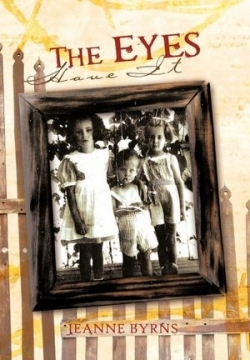The Eyes Have It
When Jeanne Byrns was a young girl she announced that she wanted to tell her teacher that she was being sexually abused by her father. Her stepmother responded with, “If you do that, your daddy will go to jail.” The stepmother threatened additional bad consequences, including jail for Jeanne herself.
Abused people may not always be able to speak out, argues Byrns, but—as she suggests in the book’s title—their eyes reveal their stories. Byrns knew that she and her two siblings were unwanted by their birth parents. Fortunately, the children did receive an abundance of love from their maternal grandparents, and this helped Byrns survive years of abuse. Her father beat her severely with his razor strap. Her stepmother, though she sometimes did inflict physical abuse, was mainly guilty of emotional abuse. Byrns was continually in a state of malnutrition and was frequently sick. In spite of all this, she believes she has an increased capacity for compassion—because of the abuse.
Byrns’ is convinced that survivors of child abuse can lead purposeful adult lives. As evidence of this, she states that she picked a good husband—on the second try—and that she became a successful medical assistant, phlebotomist, sculptor, photographer, and painter. She would have better supported her claims, though, if she had provided information about her own recovery process, including her psychotherapy. A foreword by Joan Kogelschatz, a certified psychologist and traumatologist, strengthens the book’s credibility by providing background information on the effects of child abuse.
Sonya Utterback Cirks records the vivid details of Byrns’ history of abuse, as told to her in Byrns’ own words. Language full of imagery adds impact to the narrative. For example, Byrns explains that her maternal grandparents’ love “was the life-raft that carried me to shores of survival in years to come.” She also effectively describes the temperamental personality characteristics of the significant people in her life. To illustrate her father’s extreme rages, for example, she states that he once kicked a pregnant cat in her “full fat abdomen with his steel-toed safety boots and stomped at her with his heels.”
There are, however, some problems with the writing, including errors in grammar and punctuation. In addition, inconsistencies in the chronology of Byrns’ story can cause a bit of confusion.
The Eyes Have It informs survivors of child abuse that they are not alone, and that there is hope for them. Many secrets remain hidden behind the eyes of abused children. By sharing her own traumatic experiences, Byrns hopes to help other victims through their struggles.
Reviewed by
Norma D. Kellam
Disclosure: This article is not an endorsement, but a review. The publisher of this book provided free copies of the book and paid a small fee to have their book reviewed by a professional reviewer. Foreword Reviews and Clarion Reviews make no guarantee that the publisher will receive a positive review. Foreword Magazine, Inc. is disclosing this in accordance with the Federal Trade Commission’s 16 CFR, Part 255.

